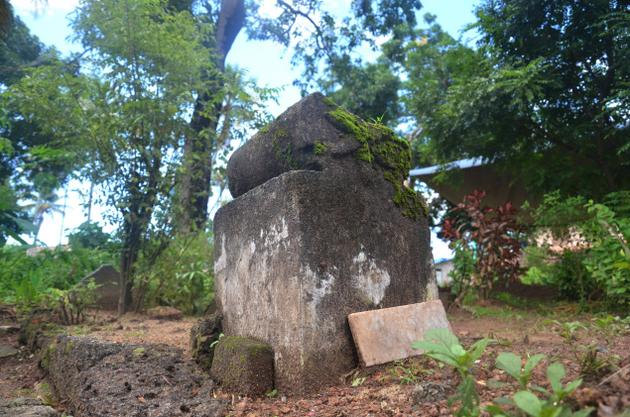
Syed Sanaullah Makthi Thangal, one of the earliest progressive Islamic scholars of Kerala, lies buried in the ancient Juma Masjid at Calvathy
In the middle of the khabaristan or burial ground adjoining the historic Juma Masjid at Calvathy, among the many grave markers, weeds and grass is one ancient grave. The tombstone is worn out and cracked, a row of laterite bricks mark out the grave, and a small neem plant has grown right in the middle. This is perhaps the only surviving memory of Syed Sanaullah Makthi Thangal (1847-1912), the famous Islamist reformer and author.
Historical documents reveal that Makthi Thangal was born at Veliyankodu, Malappuram district. But most of his creative pursuits and death happened in Kochi. He studied Arabic from his father Syed Ahmed Thangal and then enrolled at the Chavakkad Higher Elementary School. He went on to become an expert in Islamic studies and an expert in Malayalam, Arabic, Hindustani, Persian and Tamil languages.
He began his career as an excise inspector in the British government. This was a period when the Muslims in Kerala had not opened up to public education, were bound by superstitions, were gullible to accept anyone as their spiritual leader. Added to this was the government supported conversion threats. Thangal quit his job and plunged into public life. His mission was to help his community rise from the social and cultural depths into which it had fallen.
Thangal began writing, speaking and propagating his views that were bold, poetic, reformist and directed to benefit the Muslim community. Thangal wrote in the newspapers that were in circulation at that time, those that were ready to publish his articles and also published books on matters relevant to the community in British India. His speeches and all what he wrote turned out to be a clarion call to many who towed his line of thought. Thangal is considered to be the first Muslim to write, publish books and launch a daily newsletter.
Dr. C.K. Kareem, in his Kerala Muslim History, Statistics and Directory, Volume 1 (History of Kerala and of her Muslims), records that Thangal had to suffer a lot for his work. He quotes from Thangal’s concise autobiography, Makthi Manaklesham that gives a graphic account of his travails. The fierce attacks came from the conservatives within his community and from the British. But Thangal was not one to be cowed down by all this.
For nearly 30 years Thangal is said to have travelled the length and breadth of the State spreading awareness about the need for education, women’s empowerment, calling for a fight against superstition, conversion and non-Islamic beliefs.

E. Moidu Moulavi, in his preface to the collected edition of Makthi Thangal’s works (Makthi Thangalude Sampoorna Krithikal) published by Kerala Islamic Mission, Tirur, states that Thangal must have written 40 books. Though he did not have the means, found no publishers, did all that on his own. Moidu Moulavi considers Thangal’s works as a value addition to the ancient Malayalam literary style and an invaluable historical document. What makes these works more important is when one considers the time during which they were written. The language may not have the finesse but certainly did not lack the power.
“Some of Thangal’s works like Kadora Kudaram, which was a resistance against the British supported religious conversions, Muslimugalum Vidyabyasavum that exhorted Muslims to embrace Malayalam and English education and Naari Narabhichari on the need for women’s education are all revolutionary, progressive works of a genius. As Dr. C. K. Karim observes and from what I have read they were brave views that shook the conformist mindset of the community. Thangal had to suffer a lot for his writings with many slapping court cases against him,” says M.A. Aboobacker, cultural activist.
What made Thangal unique was that he was the first reformist who studied the religious aspects of various religions before formulating his views. As historian M. Gangadaran notes Makthi Thangal as a reformist who used his vast knowledge to find a way out for the Muslim community from the darkness. He understood the significance of language and insisted that it should not be a barrier for Islam.
Failing health forced Thangal to settle down permanently in Kochi. He died on September 18, 1912. Among his many disciples and followers was C.V. Abdurahman Hydrose, editor of Malabar Islam. “Hydrose Sahib stayed at Darussalam Road. His father was also known to Makthi Thangal. It is said that Thangal presented his pen to Hydrose Sahib telling him that he has nothing else to give him and prayed that this pen would be helpful to him.
As Moidu Moulavi writes, Hydrose Sahib, true to the legacy he inherited, went on to publish many of Thangal’s works including Makthi Vijayam,” says Aboobacker.
Once in a while people visit Thangal’s grave, people who have read about him, who have read his works. “It was my friend Gaffoor who first told me about Thangal’s grave. I had read a lot about him and also some of his writings. In January 2013, when Gaffoor came down from Muscat, we went for the Biennale. We then decided to find out where Thangal’s grave was. It took us a lot of wandering, asking many people to finally find it. I feel Thangal who has contributed so much for nourishing and reforming the Muslim community deserves more”, feels R.P. Sivan, a Malayalam teacher at SRV High School.
Apart from a literary award instituted by an organisation in Makthi Thangal’s name there is nothing else to perpetuate the memory of this visionary reformer.
Perhaps, adapting Emily Dickinson’s lines, after a hundred years nobody would know this place. Weeds will rage triumphant, strangers will stroll past this lone tombstone, no one to tell them of the man buried there; lost to memory.
source: http://www.thehindu.com / The Hindu / Home> Features> MetroPlus> Hidden Histories / by K. Pradeep / Kochi – October 31st, 2014








